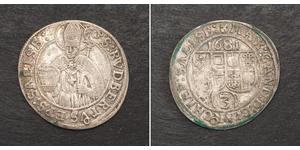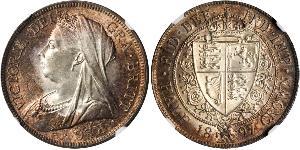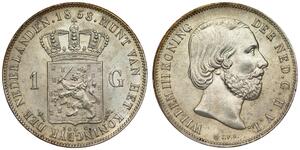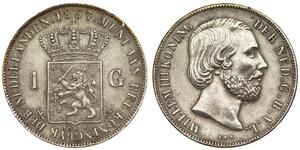(售价 $1535.0)
1399, Gelderland, Oyen, Maria of Brabant. Scarce Gold Gulden Coin. RR!
Mint Place: Oyen
Mint Period: 1361-1399 AD
Region: Gelderland (Netherlands)
Denomination: Gold Gulden (also known Rider Gulden).
Condition: Minimal weakness of strike in center, otherwise XF!
Reference: Delmonte 245 (R3!), Friedberg 41 ($1250 in VF / $2500 in XF!). Very Rare!
Diameter: 22mm
Weight: 3.48gm
Material: Gold!
Obverse: Crowned half-length bust beneath Gothic arch, flanked by two turrets. Shield of Gelderland below.
Legend: MARIA : DVC IS : GLREN'
Reverse: Two shields within polylobe. Six trefoil decorations in outer fields. All within inner circle.
Legend: + BENEDICT : QVI : VENIT . IN : NIMINE ("Blessed who comes in name of Lord!")
Expanded: Benedictus qui venit in nomine Domini.
em>.
Maria of Brabant (1226–1256) was a daughter of Henry II, Duke of Brabant and Maria of Swabia. She married Louis II, Duke of Bavaria, being the first of three wives.
Maria was the fifth of six children born to Duke Henry by his first wife. Her mother Maria was a daughter of Philip of Swabia. Maria's siblings included Henry III, Duke of Brabant and Matilda of Brabant. After the death of her mother, her father remarried to Sophie of Thuringia, from this marriage she gained two half-siblings including Henry I of Hesse.
Maria was most likely betrothed in 1247 to Prince Edward, son of Henry III of England. The betrothal of one of the daughters of Henry II Duke of Brabant to Edward is recorded by Matthew Paris. It is not certain that Maria was the daughter in question. However, she is the most likely candidate as her two older sisters were already married and her younger half-sister was only an infant at the time. However negotiations came to nothing.
On 2 August 1254, Maria was married to Duke Louis. The couple were married for only two years, in which time they had no children.
Maria was executed by beheading in Donauwörth in 1256, after being accused of adultery by her husband, following the standard practice for women found guilty of adultery; however, proof of guilt of adultery on her part could never be validated. As expiation, Louis founded the Cistercian friary Fürstenfeld Abbey (Fürstenfeldbruck) near Munich.
Sources tell varying tales about how the event occurred. In 1256 Louis had been away from home on state affairs for an extended period of time in the area of the Rhine. His wife wrote two letters, one to her husband, and another to the earl of Kyburg at Hunsrück, a vassal of Ludwig. Details about the actual content of the second letter vary, but according to the chroniclers, the messenger who carried the letter to Louis had been given the wrong one, and Louis came to the conclusion that his wife had a secret love affair.Over time, a great many tales of folklore sprang up around Louis' bloody deed, most of them written long after Louis' death: Ballad-mongers embellished the tale into a murderous frenzy, during which Louis allegedly not only killed his wife after having ridden home for five days and nights, but also stabbed the messenger who brought him the wrong letter, then upon entering his castle stabbed his own castellan and a court lady and threw his wife's maid from the battlements, before he massacred his wife either by stabbing her or cutting off her head.
1 Gulden 荷兰王国 銀
本组有 5 钱币 / 5 售价
⇑
























